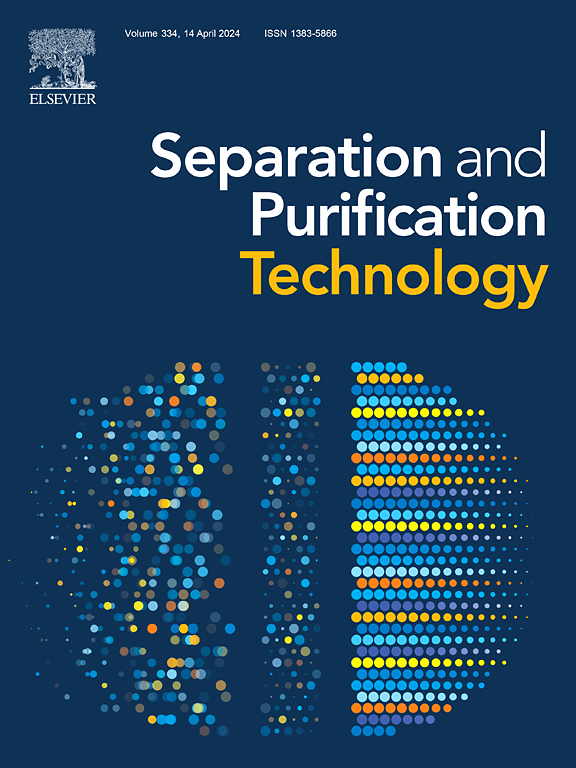Highly selective and efficient gold recovery from ferricyanide-thiourea synergistically catalyzed thiosulfate leachate by diphenylphosphine extraction and acidic thiourea back-extraction
IF 8.1
1区 工程技术
Q1 ENGINEERING, CHEMICAL
引用次数: 0
Abstract
Thiosulfate is a promising cyanide alternative. Our recent research has revealed that the ferricyanide (Fe(CN)63−)-thiourea (TU) synergistically catalyzed thiosulfate system holds great potential for leaching gold. This paper investigated the gold recovery from Fe(CN)63−-TU-S2O32− leachate by diphenylphosphine (HDPP) extraction and acidic thiourea (HCl/TU) back-extraction. HDPP was confirmed to have outstanding extraction percentage, excellent selectivity towards gold and high recycling stability. Under optimal conditions, nearly 100 % gold extraction was obtained within 10 min with minimal extraction of other metal ions. Even after five extraction cycles using HDPP, the gold extraction percentage remained above 99 %. Among the explored strippers, HCl/TU exhibited remarkable gold stripping performance. More than 99 % gold was obtained after five stages back-extraction. Driven by the synergistic effects of H+ and TU, the σ bond between P and Au was readily broken, enabling the simultaneous HDPP regeneration and gold stripping. The HDPP regenerated after five stripping stages still achieved a gold extraction percentage of over 99 %. This study provides a novel perspective on gold recovery from its thiosulfate leachate and significantly contributes to the advancement of industrial application of iron-based thiosulfate gold leaching systems.

二苯基膦萃取和酸性硫脲反萃取协同催化硫代硫酸盐浸出液中金的高选择性高效回收
硫代硫酸盐是一种很有前途的氰化物替代品。我们最近的研究表明,铁氰化物(Fe(CN)63−)-硫脲(TU)协同催化的硫代硫酸盐体系具有很大的浸金潜力。研究了用二苯基膦(HDPP)萃取和酸性硫脲(HCl/TU)反萃取法从Fe(CN)63−-TU-S2O32−渗滤液中回收金。结果表明,HDPP萃取率高,对金的选择性好,回收稳定性好。在最佳条件下,在10 min内,金的提取率接近100% %,其他金属离子的提取率最低。在HDPP萃取5次后,金的提取率仍保持在99% %以上。在已勘探的提矿剂中,HCl/TU表现出较好的金提矿效果。经过5段反提,金含量达到99% %以上。在H+和TU的协同作用下,P和Au之间的σ键容易断裂,使HDPP再生和金剥离同时发生。经过5段提金后再生的HDPP金提取率仍可达99% %以上。该研究为从硫代硫酸盐浸出液中回收金提供了新的思路,对推进硫代硫酸盐铁基浸出金系统的工业应用具有重要意义。
本文章由计算机程序翻译,如有差异,请以英文原文为准。
求助全文
约1分钟内获得全文
求助全文
来源期刊

Separation and Purification Technology
工程技术-工程:化工
CiteScore
14.00
自引率
12.80%
发文量
2347
审稿时长
43 days
期刊介绍:
Separation and Purification Technology is a premier journal committed to sharing innovative methods for separation and purification in chemical and environmental engineering, encompassing both homogeneous solutions and heterogeneous mixtures. Our scope includes the separation and/or purification of liquids, vapors, and gases, as well as carbon capture and separation techniques. However, it's important to note that methods solely intended for analytical purposes are not within the scope of the journal. Additionally, disciplines such as soil science, polymer science, and metallurgy fall outside the purview of Separation and Purification Technology. Join us in advancing the field of separation and purification methods for sustainable solutions in chemical and environmental engineering.
 求助内容:
求助内容: 应助结果提醒方式:
应助结果提醒方式:


